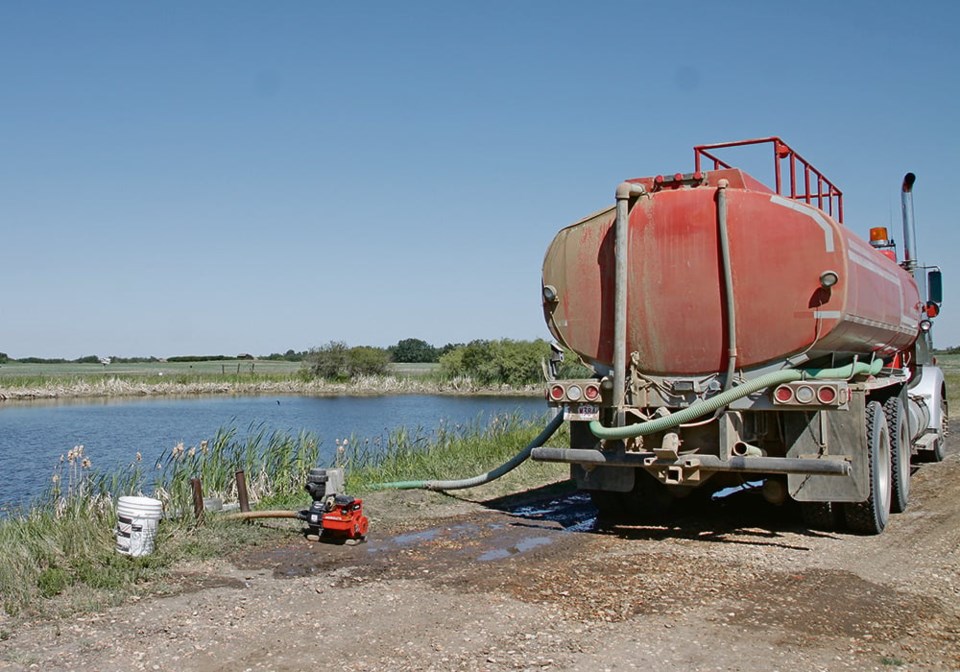WESTERN PRODUCER – On the Canadian Prairies, a green Christmas doesn’t exist. However, a brown Christmas sure did in 2023, thanks to El Niño.
Snow was scarce on the Prairies earlier this winter, with temperatures rarely falling below -20 C, or even -10 C. With a drought stretching through multiple years, the dry winter is causing even more concern the Prairies won’t see as much runoff as usual, which could also affect water quality in dugouts.
Dwayne Summach is a livestock and feed extension specialist with the Saskatchewan government and is well known across the industry for his expertise when it comes to water-related issues.
Summach says one of the obvious concerns going into the spring after a winter like 2023-24 is the lack of runoff and the amount of water that will be available in dugouts.
“As quantity becomes limited, then quality becomes more important,” he says.
Water in dugouts changes over the course of the year due to evaporation, water consumption, runoff and rainfall.
“So runoff happens, dugouts are filled or get the water that they’re going to have for the summer at the beginning of the year, and water quality is often a certain level,” Summach says. “And as evaporation happens, as consumption happens,the salts are left in the dugout, and so they get concentrated.”
As a result, water usually starts at a higher quality in the spring because of the runoff, and then decreases because of hotter temperatures, which increase evaporation.
Rainfall can improve water quality but must be substantial — 75 or more millimetres in a day — to make a notable difference.
“We haven”t seen many of those.”
Summach says work has been done with Saskatchewan government researchers at the Moose Jaw office on water quality changes in dugouts over time.
They have monitored a dugout for multiple years and data shows water quality usually degrades as the season progresses.
According to Summach, in 2022 the sulphate levels in the dugout started at 1,400 milligrams per kilogram. By the fall, those levels had increased to 7,000. In 2023, sulphate levels started at below 100 and rose to around 3,000 by the end of the year. Usually, around 3,000 milligrams per kilogram is when experts recommend cattle not consume water from that source.
They also collected data on how rainfall affected the quality of the dugout they were monitoring.
“When we look at the data specifically on that dugout, you can identify when there are significant rainfall events and recharge,” Summach says.
“And so, what will often happen is you’ll get a slight improvement in water quality, but more often than not, it really just causes a bit of a plateau.”
At the Saskatchewan Beef Industry Conference earlier this year, Dr. Vanessa Cowan spoke about toxicology in cattle in Saskatchewan.
Cowan works at the Western College of Veterinary Medicine, where she researches toxicology and helps operate the toxicology lab.
While many toxicity situations with cattle occur in many places, Cowan said some of them involve water.
This includes sulphate poisoning, salt poisoning and blue-green algae.
Excess salt consumption causes poisoning, but the more common cause is insufficient water consumption or lack of access to water.
Sulphate poisoning is often caused by drought and can cause blindness, seizures and loss of balance. Cowan says sulphate poisoning is more common now than it used to be.
“Saskatchewan has had an all-time history of high sulphate in water, which will decrease the copper that’s absorbed in the animal, also contributing to copper deficiency,” she says.
Blue-green algae, on the other hand, is more common than salt poisoning and is an issue that concerns many producers.
Symptoms of blue-green algae poisoning include staggering, weakness, difficulty breathing and convulsions, which can result in death.
“Oftentimes, we won’t be alerted to a problem until animals have died from drinking the water with the algae.”
She says producers should watch for blue-green algae blooms during prolonged periods of hot weather, as well as in areas where there is agricultural runoff.
“We have a semi-quantitative test at the moment, where we can tell you above a certain concentration if the water is contaminated,” Cowan says.
Summach says electrical conductivity is the most practical test of dugout water quality.
Producers have two options — purchasing electrical conductivity meters or bringing samples to their regional government offices for testing.
“We have meters available to measure electrical conductivity. And then if need be, we can forward it to the lab for further testing and further analysis,” he says.
Hand-held conductivity meters cost less than $200, but they are good for only about six months, and replacing the tip costs approximately $150. Because there’s a variety of products of different qualities, this can vary. He says producers also must ensure they get their meter calibrated.
Value for investment in a meter will also depend on the number and location of dugouts to be tested.
The current El Nino could continue into summer, which will likely mean high temperatures. Summach says that makes it even more important to know dugout water quality.
Poor quality water can affect animal well–°¿∂ ”∆µ, he says.
“It impacts their immune system function, impacts reproduction and impacts a lot of different things.”




